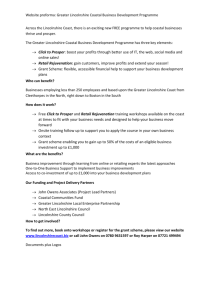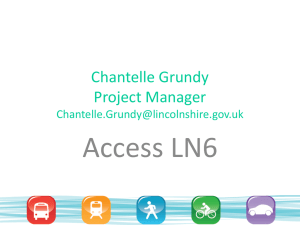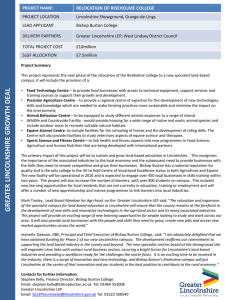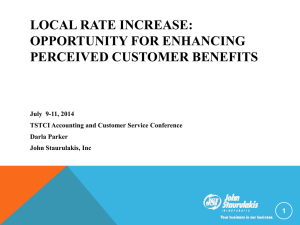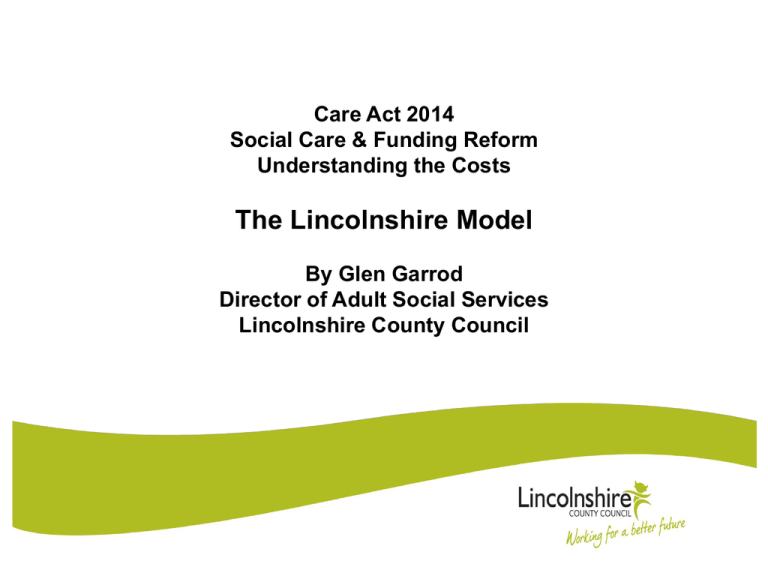
Care Act 2014
Social Care & Funding Reform
Understanding the Costs
The Lincolnshire Model
By Glen Garrod
Director of Adult Social Services
Lincolnshire County Council
Lincolnshire Context
•
•
•
•
•
•
•
Population of 718,800
Predominantly Low Skilled, Low Paid Economy, Pockets of Deprivation
Lowest quartile in terms of council tax rates
29% of total service budget spent on social care in 2013/14
Cost of in-house services reduced from £27m to £3m between 2011/12 & 2013/14
Revenue Budgets in 2013/14
• Gross £206.431
• Net £140.709
Additional ongoing Cost Pressures identified including:
• Demographic Growth (Highest Growth of over 75s in East Midlands)
• On-going pressures within Learning Disabilities Services
• Residential and Nursing rate agreements
• Impact of Care Act and Dilnot recommendations
• Integration with Health
The Lincolnshire Model
Attempts to estimate the additional cost to Lincolnshire County Council
as a direct result of the implementation of the Care Act 2014.
• Increase in Asset Thresholds
• Implementation of the Care Cap
• Statutory Responsibilities to Carers
• Additional Assessment Activity
• Loss of Existing Service User Income
The Lincolnshire Model
Concept of the model is simplicity, with the emphasis on local variation so that it
can easily adjusted to suit local conditions and is built on the following basis:
•
Use of Formulae where possible
•
Use information that is generally available to all (e.g. Service User and
Brokerage data)
•
Use recognised assumptions around areas such as inflation and asset values
•
Incorporate other pieces of intelligence
The Lincolnshire Model
Sources of Data Include:
• Existing Service User Data
• Average levels of Income for Self Funders
• Model the impact of threshold increases on existing SU
• Establish Attrition Rates
• Laing & Buisson Evaluation of Lincolnshire Residential Sector
• Used to calculate estimate of self funders
• Detail of self funder rates
• Brokerage Data
• Establish average hourly rates of Dom Care
• Establish average hours of care delivered
• Land Registry Data to establish average property values around
• Terraced
• Semi Detached
• Detached
• Maisonettes
• Staff and Assessment Data to establish cost of additional assessment activity
The Lincolnshire Model
Findings:
•
Cost to Lincolnshire over ten years estimated to be £157m
•
Impact of threshold will be felt immediately
• £6.4m cost of new services users
• Reduction in existing contributions £1.7m
• Total financial impact including on-going assessment costs in 2016/17 is
£11.7m
•
Impact of Care Cap not felt until Year 7 (2022/23)
• Due to lower than average cost of residential care
•
Impact does not reduce over time, at year 10 (2025/26) additional financial
impact totals £20.6m
The Lincolnshire Model
Analysis Year 1 – from 2016/17
Analysis Against Actual Costs
2013/14 Actuals (£m) Dilnot Outcomes Yr 1 (£m)
%
OP Net Residential Spend/Additional Cost
64.945
6.482
10%
OP Gross Expenditure/Additonal Cost
88.803
6.482
9%
OP Residential Income/Loss of Income
21.675
0.390
2%
OP Non Residential Income/Loss of Income
5.246
0.234
4%
WAA Residential Income/Loss of Income
2.759
1.028
37%
WAA Non Residential Income/Loss of Income
0.667
0.077
12%
Adult Care Total Gross Cost
206.431
11.754
5%
Adult Care Total Net Cost
140.709
11.754
8%
The Lincolnshire Model
Analysis Year 10 – 2025/26
2013/14 Actuals
(£m)
Dilnot Outcomes Yr 10
(£m)
%
OP Net Residential Spend/Additional Cost
64.945
17.382
27%
OP Gross Expenditure/Additonal Cost
88.803
17.382
20%
OP Residential Income/Loss of Income
21.675
0.146
1%
OP Non Residential Income/Loss of Income
5.246
0.074
1%
WAA Residential Income/Loss of Income
2.759
0.539
20%
WAA Non Residential Income/Loss of Income
0.667
0.027
4%
Adult Care Total Gross Cost
206.431
20.617
10%
Adult Care Total Net Cost
140.709
20.617
15%
Analysis Against Actual Costs
The Lincolnshire Model
Next Steps:
•
Continued work to establish the cost of reforms with regional and national
finance groups
•
Further validation and correction of the model
•
Look to establish other examples of best practice and apply to the model
•
Establish the impact of any significant revisions pre/post general election
•
Apply further budgetary changes e.g. changes to residential rates
The Lincolnshire Model
Headline findings - support
99% of councils said they were aware of the tools and support that have been developed
nationally (Q45). Councils were asked which tools have advanced their confidence in
delivering the Care Act (Q45a), and also to outline any additional support, guidance or
information that would increase their confidence for implementation in 2015 (Q46). Their
responses are below:
Additional tools, guidance or information
requests (Q46)
Existing tools that have “most
advanced confidence in ability to
More timely release of regs/guidance/allocations
deliver Care Act reforms” (Q45a)
Financial modelling tools and information
Revised Lincolnshire model
90%
Greater clarity on eligibility
Care Act Factsheets
86%
Workforce development tools
Care Act Clause Analysis
82%
Peer support and best practice sharing
Draft regulations and guidance
80%
National communications tools
Care Act Stocktake
78%
Legal support
Draft capacity planning model
66%
Continued focus on technology suppliers
ADASS updates
66%
National guidance on IFAs
23/10/2014
Care Act Stocktake and support
10

